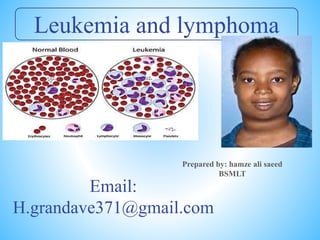
leukemia and lymphoma
- 1. Leukemia and lymphoma Email: H.grandave371@gmail.com Prepared by: hamze ali saeed BSMLT
- 3. * Leukemia is a group of cancers that usually begin in the bone marrow and result in high numbers of white blood cells. These white blood cells are not fully developed and are called blasts or leukemia cells. Clinically and pathologically, leukemia is subdivided into a variety of largegroups. The first division is between its ACUTEand CHRONIC forms.
- 4. * Acute leukemia is characterized by a rapid increase in the number of immature blood cells. The crowding that results from such cells makes the bone marrow unable to produce healthy bloodcells. Immediate treatment required because of the rapid progression and accumulation of the malignant cells. Most common form of leukemia inchildren.
- 5. * It is characterized by the excessive buildup of relatively mature, but still abnormal, white bloodcells. Typically taking months or years to progress, the cells are produced at a much higher rate than normal, resulting in many abnormal white blood cells. Chronic leukemia are monitored for sometimes before treatment to ensure maximum effectiveness of therapy. Mostly occurs in older people, but can occur in any age group.
- 6. * The diseases are subdivided according to which kind of blood cell is affected. This divides leukemias into lymphoblastic or lymphocytic leukemias and myeloid or myelogenous leukemias. In lymphoblastic or lymphocytic leukemias, the cancerous change takes place in a type of marrowcell that normally goes on to form lymphocytes. Most lymphocytic leukemias involve a specific subtype of lymphocyte, the B-cell.
- 7. In myeloid or myelogenous leukemias, the cancerous change takes place in a type of marrowcell that normally goes on to form red blood cells, some other types of white cells, andplatelets. There are some types of subcategories like hairy cell leukemia(subset of chronic lymphocytic leukemia), T- cell prolymphocytic leukemia(very Rare and aggressive), large granular lymphocytic leukemia(involve either T-cells or Nk cells, adultT-cell leukemia (caused by human T- lymphotropic virus), clonal eosinophilias (mutation in hematopoietic stem cells).
- 8. * Acute lymphoblastic leukemia. Acute myeloid leukemia. Chronic lymphocytic leukemia. Chronic myeloid leukemia.
- 9. * Most common type of leukemia in youngchildren. It also affects adults, especially those 65 andolder. Standard treatment involve chemotherapy and radiotherapy. The survival rate vary by age :85% in children and 50% in adults.
- 10. * Most often affects adults over theage of 55. Sometimes occurs in younger adults, but it almost never affects children. Two-third of affected people are men. It is incurable , but there are many effective treatments. The five year survival rate is75%.
- 11. * It occurs more commonly in adults than in children, and are more commonly in men than women. It is treated with chemotherapy. The five year survival rate is40%.
- 12. * It occurs mainly in adults; a very small number of children also develop thisdisease. It is treated with imatinib (Gleevec in United states, Gluivec in Europe). The five year survival rate is90%.
- 13. * Bleeding. Bruising. Feeling tired. Fever. Increased risk of infections. Pale skin. An enlarged spleen.
- 15. * Mutation in the DNA Inherited Viruses Radiation Non-ionizing radiation
- 16. * Smoking. Family history. Ionizing radiation. Some chemicals. Down syndrome.
- 17. * BLOOD TEST: Complete blood counts(white blood cell count increasesabnormally). LYMPHNODE BIOPSY:Performed to diagnose certain types of leukemia in certain situations. BONE MARROW THERAPY: abnormal cell division in the bone marrow WBC’s amount continues to increase. X-ray (bones),MRI(Brain),Ultrasound(kidney, spleen, liver).
- 18. *
- 19. * Lymphoma is a group of blood cell tumors thatdevelop from lymphocytes(a type of white blood cell). Lymphoma most often spreads to the lungs, liver,and brain. Lymphoma’s symptoms are like enlarged lymph nodes , fever, sweat, itching etc. The enlarged lymph nodes are usually painless. There are two types of lymphomas: • Hodgkin’s lymphomas • Non- hodgkin lymphoma. About 90% of lymphomas are non-hodgkin lymphomas.
- 20. * Hodgkin lymphoma is one of the most common known types of lymphomas. A hodgkin lymphoma is marked by the presence of a type of cell called the reed-sternbergcell.
- 21. * Enlarged lymph nodes Or lymphadenopathy. Bsymptoms (systemic symptoms)- can be associated with both Hodgkin lymphoma and non-hodgkin lymphoma. They consist of : • Fever • Night Sweats • Unintended weight loss • Itching • Feeling tired/fatigue. • Anorexia or loss of appetite.
- 22. * Risk factors for Hodgkin lymphoma include infection with, • Epstein-barr virus. • History of the disease in the family. Risk factors for common types of non-Hodgkin lymphomas include, • Autoimmune disease. • HIV/AIDS. • Infection with human T- lymphotropic virus. • Immunosuppresant medications. • Pesticides. • Tobacco smoking.
- 23. * Lymph Node Biopsy. • A partial or total excision of a lymph node examined underthe microscope. • This examination reveals the histopathology features thatmay indicate lymphoma.
- 24. * Treatment may involve chemotherapy, medication, radiation therapy and rarely stem-cell transplant. Medications Chemotherapy, Bone marrow stimulant, Steroid, and Blood transfusion Surgery Autotransplantation
- 25. * Clinical pharmacy and therapeutics, RogerWalker Rang & Dale’s pharmacology Essential of medical pharmacology, K D Tripathi www.google.com